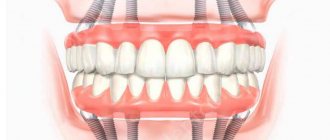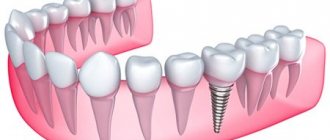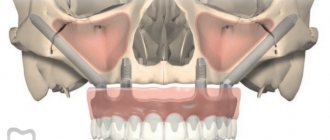Classic dental implantation is performed in two stages and is the safest and most reliable method. Prices, stages and advantages of two-stage implantation.
When it comes to the classic method of dental restoration, many patients try to avoid this topic. This is due to a number of factors, including a significant delay in the procedure, the need for frequent visits to a specialist and insufficient aesthetics during the period of implant healing. For these reasons, most visitors tend to resort to one-stage or one-time implantation.
However, the two-stage technique also has its positive aspects, which can be counted on if a competent approach to treatment is used and strict adherence to all its stages.
Our Implantmaster clinic employs highly qualified and experienced specialists who are fluent in all the intricacies of performing such operations and guarantee its effectiveness. In this article we will talk about what two-stage dental implantation is. You will learn about its main “advantages”, as well as get acquainted with the advantages and possible limitations for its implementation. We will also tell you about the prices that exist in the capital’s clinics and describe in detail all stages of treatment. These and other points will be discussed in the article below.
What is classic dental implantation?
Classical dental implantation is considered one of the most common and reliable methods, since it provides the possibility of a more durable fusion of the installed structure with the bone tissue. This name was given to the procedure due to the fact that it is carried out in stages: the period between fixation of a dental implant and installation of a crown can reach 4-6 months (3-4 weeks when using Straumann implants), which can significantly minimize the likelihood of rejection. In turn, the possibility of subsequent prosthetics is achieved due to the presence of a special adapter, which is installed after completion of the osseointegration process.
Bone grafting
If it turns out that you have insufficient bone tissue, your doctor will prescribe surgery to build it up. Depending on the situation, this may be bone block transplantation, sinus lift, or bone regeneration. Only after rehabilitation (which will take 3-4 months) will it be possible to begin further actions, namely, begin installing implants.
Bone block transplantation
If you had a tooth removed more than 3 months ago, be prepared for the fact that in preparation for classical implantation you will also need to build up bone. After all, the atrophy process starts almost instantly after the tooth root is extracted.
Advantages of two-stage dental implantation
The wide demand for two-stage dental implantation is due to the presence of a number of advantages, which include:
- Increased reliability of the technique, which is associated with a full engraftment process long before fixation of the artificial prosthesis;
- Possibility of restoring ideal aesthetics after massive tooth loss;
- Classic dental implantation involves the use of systems from various manufacturers;
- Eliminates the risk of bone loss and improves its ability to grow;
- Low probability of design rejection;
- Possibility of performing various types of prosthetics;
- By using a special component to form the natural contour of the gums, the necessary aesthetic effect is ensured.
In addition to the above positive aspects, two-stage dental implantation has another key advantage - the ability to distribute cash payments over time.
Advantages
- Reliability. According to dental statistics, in most cases, 2-stage implantation is completed successfully. Artificial implants take root successfully and perform all basic functions; the risks of rejection are reduced.
- Predictable result. Already at the stage of preparation for surgery, the doctor can predict the outcome. It takes into account the condition of the bone tissue, the selected implant, the general condition of the teeth, hard and soft tissues.
- Sterility. After opening the gums and inserting the artificial tooth, sutures are placed, which minimizes the risk of pathogens entering through the open wound.
- Comfortable terms. A short break between osseointegration and installation of a permanent crown allows the implant to take root successfully, and the patient to prepare mentally and financially for the next stage of implant installation.
- Adequate healing time. If the implantation operation is performed on the lower jaw, the complete healing period takes about three months. For the upper jaw, the period of complete healing of implants is approximately six months.
- Impeccable aesthetics. With the right approach, using individual formers, you can form an impeccable gum contour. Modern dentures also look as natural as possible.
Possible nuances of the operation include timing, which may not suit the patient individually. Some people are not ready to wait six months or more for the implant to take root. But the time and money spent will pay off with a beautiful and healthy smile! Also, the classical method of dental implantation in two stages may not be suitable due to the relative trauma - incisions and sutures cannot be avoided.
Covering the implant site with a mucosal flap at the initial stage provides the most optimal conditions for osseointegration. This approach prevents the penetration of infection from the oral cavity and eliminates mechanical stress. The design of the implant allows installation in more difficult conditions and with a higher probability of engraftment.
Carrying out any dental implantation in our clinic allows you to get the expected result, in which the implant 100% replaces the tooth, thanks to:
- development of an individual implant treatment plan;
- constant medical supervision at each stage of implantation;
- strict adherence to recognized international standards and surgical protocol;
- use of reliable technologies, implants from leading manufacturers (ANKYLOS, ALFA BIO, BioHorizons, Nobel Replace);
- highly qualified team of professionals.
Advantages of two-stage dental implantation:
- The highest percentage of successful engraftment. These are not just marketing statements, but an objective fact - if implantation is carried out with opening of the gums, the doctor clearly sees the surgical field, and does not insert the implant almost “at random”, as in the transgingival method (without an incision).
- The ability to use a two-stage implantation method to restore any number of teeth. This is an important point, because any options for single-phase implantation are used only if it is necessary to restore several missing teeth in a row. While single-phase implantation is contraindicated for one tooth.
- Objective cost, no expenses for temporary prosthesis. The patient is immediately fitted with a permanent crown or bridge made from pre-selected materials. Since prosthetics are performed when the titanium rod has already completely taken root, prostheses with any “weight” are suitable - metal-ceramic, all-ceramic, zirconium dioxide.
The two-stage implantation technique is in great demand due to its many advantages. When drawing up a treatment plan, the following positive aspects of the procedure become key for the dentist:
- the possibility of restoring a smile in the absence of teeth on one or both jaws;
- high reliability of this method of implanting a metal rod due to its complete osseointegration even before the installation of an artificial crown;
- a wide selection of models and brands of implants that can be used with the classical procedure;
- minimal risk of design rejection;
- preventing bone tissue atrophy and accelerating its growth after the introduction of a titanium rod;
- high final aesthetic indicator, thanks to the use of a special gum former, which promotes the correct growth of gum tissue around the protruding part of the structure;
- the possibility of using the implant for various types of prostheses.
Cash payments for the procedure are evenly distributed over time.
Installing implants in two stages has the following advantages:
- The most reliable and proven method.
- Characterized by the highest percentage of engraftment of titanium structures.
- Minimal risk of implant rejection.
- Allows you to restore both one tooth and multiple tooth losses.
- An implant installed using a two-stage method prevents bone tissue atrophy and stimulates its formation around itself.
- Implants can serve as support for removable dentures, thereby improving their fixation.
- Gives a good aesthetic effect.
Disadvantages of classical dental implantation
In addition to the advantages, classical dental implantation has significant “disadvantages”, which we will discuss below:
- Long period of the procedure. Before fixing an artificial crown, it is necessary to wait for the full healing process, which may take several weeks or months;
- Increasing the frequency of visits to a specialist. A prerequisite for successful treatment in this case is regular visits to the dentist during the entire period of osseointegration. This allows you to monitor all changes in the area of the installed structure and eliminates the likelihood of developing peri-implantitis;
- Insufficient aesthetic indicators during engraftment. A significant “disadvantage” of the procedure is the presence of gaps in the dentition, which the patient has to put up with until osseointegration is completed and the crown is fixed.
Stock
-6%
BASAL COMPLEX - Restoration of teeth on 1 jaw in 3 days 265,000 rub.
250,000 rub.
get -40 %
Promotion for installation of veneers!
30000 rub. 18,000 rub.
get -16 %
Premium implantation Nobel and zirconium dioxide crown 125,000 rub.
105,000 rub.
get -25 %
Removable denture for 1 jaw RUB 20,000.
15,000 rub. get
Stages of two-stage dental implantation
So, two-stage dental implantation has an important feature - the separation of stages in time. This allows the doctor to carry out the necessary manipulations after certain periods, significantly increasing their efficiency and reliability.
Preparation
Before performing surgery, the specialist examines the oral cavity and asks the patient questions that allow him to get a complete picture of the existing diseases and judge possible limitations. Also a necessary condition for the classical technique is tomography or radiography.
In the absence of sufficient bone tissue, osteoplasty is performed. In some situations, it may be necessary to expand the thickness of the maxillary fundus.
If during the examination carious lesions or inflammatory processes in the area of gingival tissue are discovered, it is necessary to urgently address them. This will prevent the possibility of subsequent spread of infection at the site of future implantation.
Learn more about computed tomography (CT) »
Surgical intervention
Involves direct fixation of a dental implant. Consists of the following steps:
- The use of general or local agents that provide reliable anesthesia for the area planned for implantation;
- Opening access to bone tissue by making an incision and tilting back part of the gum;
- In accordance with the shape of the selected implant, the doctor forms a hole in the bone tissue, which must be processed with a milling cutter and cleaned of sharp parts;
- The implant with the appropriate parameters is installed in the bed, after which the plug is fixed. At this step, it is necessary to eliminate the possibility of excessive heating of the bone, which requires special care and attention from the doctor;
- The detached part of the gum is sutured.
This completes the first phase of the operational phase. Next, the process of engraftment of the structure begins, from 8 to 24 weeks, during which any additional procedures are excluded. When installing Swiss Strauman implants, this period is significantly reduced to 3-4 weeks .
After osseointegration is completed, there is a need to create the correct gingival contour and use a special former. The installation procedure is as follows:
- Local anesthesia is administered in the area of the previously installed implant;
- Next, the gum flap in this area is removed;
- The device necessary to form the correct gingival margin is fixed. It is placed instead of a plug. The healing period can reach 2 weeks.
For the purpose of further installation of a temporary or permanent prosthesis, a special adapter is used, which is attached to the former.
Prosthetics
The final stage after complete engraftment of the dental implant and regeneration of gum tissue is the installation of a permanent crown on the implant. This process is preceded by the creation of an impression of the area where implantation was previously performed. After sending it to the laboratory and making a permanent orthotic, the doctor plans the final procedure. Next, the prosthesis is directly fixed using a special cement composition. Additionally, the specialist advises the patient on the necessary rules of oral care. At this point , two-stage dental implantation ends, since all its stages are considered completed.
Read more about installing a crown on an implant »
Terms and requirements
One-stage dental implantation can be performed if the following conditions are met:
- general satisfactory condition of the patient’s body;
- sufficiently dense bone tissue of optimal thickness - ensures strong fixation and eliminates risks (it should be possible to install a structure up to 1.6 cm long);
- a sufficient volume of soft tissue to immobilize the implant and allow the formation of gums around the structure;
- the presence of a large number of healthy teeth - in order to redistribute the chewing load and reduce pressure on the implant.
Practice shows that successful one-stage implantation is more often performed in young patients with their own healthy teeth. Installing an implant immediately after tooth extraction allows you to prevent structural changes in bone tissue - in some cases it is more advisable to immediately resort to restoration of the dentition rather than wait for complete healing. However, most patients are recommended to undergo classical two-stage implantation - it is no less effective.
What is the difference between one-stage and two-stage dental implantation?
When two-stage dental implantation , a higher quality of osseointegration is noted, since there is no risk of interaction with the environment and the likelihood of bacteria entering is eliminated. If a one-stage method takes place, then in the first three weeks there is the possibility of infection from the oral cavity, which negatively affects the engraftment process. Therefore, despite the long period of implementation, classical dental implantation allows us to guarantee more effective treatment results. This is the main difference between one-stage and two-stage dental implantation .
Our clinics
Clinic "Elident" on Varshavskaya
Varshavskoe highway, 75, bldg. 1, Moscow 117556
- Varshavskaya (500 m, closed until 2021)
- Nakhimovsky Prospekt (1,300 m)
Mon-Sat : 09:00-21:00; Sun : 09:00-19:00.
Online registration
+7 (495) 411-93-63
Elident Clinic in Annino
Varshavskoe highway, 154, building 1, Moscow 117405
- Annino (500 m)
- Academician Yangelya (700 m)
Mon-Sat : 09:00-21:00; Sun : 09:00-19:00.
Online registration
+7 (495) 411-93-63
Restrictions for the procedure
The classical technique is not prescribed if the patient has diseases of the skeletal system, weakened immunity, impaired hematopoiesis, severe diabetes mellitus, or detection of neoplasms. In this case, removable dentures are used.
Contraindications also include the period of bearing a baby and feeding him breast milk, the presence of inflammatory foci in the respiratory tract and infectious diseases.
Get information about any limitations you may have when visiting a dentist.
One-stage and two-stage implantation: what is the main difference?
The main difference is the timing of the procedure. With the classical method, at least 4 months must pass before the permanent structure is fixed. If you are interested in the most popular dental implantation techniques, one-stage is superior to two-stage, since you can get new teeth immediately after the operation is completed.
Indications and contraindications for classical implantation
According to most dentists, two-stage dental implantation is performed in the following cases:
- In the presence of bone tissue with significant friability;
- Slow rates of wound healing;
- Problematic gums;
- If a lot of time has passed since the extraction of teeth, as a result of which there is a need to form a gingival contour;
- Excessive use of tobacco products, which precludes other types of implantation.
As for the restrictions for performing classical dental implantation, the absolute prohibitions include:
- Low blood clotting rates;
- Increased blood sugar levels;
- Psychogenic disorders;
- The presence of oncological processes in the body;
- Strengthening the muscle tone of the jaw;
- Sexually transmitted diseases.
Also, classical dental implantation is not recommended in the presence of the following absolute contraindications:
- Bite changes;
- The period of bearing a child;
- Inadequate oral care;
- HIV;
- The presence of carious lesions and inflammatory processes in the oral cavity.
Comments
After installing a two-stage implant, when the anesthesia wears off, does your jaw or gums hurt? How strong? If the pain cannot be tolerated, what measures are taken? And the cost of two-stage dental implantation?
Ekaterina (03/18/2019 at 06:23 pm) Reply to comment
A year ago, I had a two-stage implant installed, everything went great, without any problems, from the installation of the implant itself to the crown. I'm very pleased with the result. But no matter how much I asked different doctors whether it was necessary to change the crown and after what time to change it, if necessary, no one answered me. Can a crown last a lifetime? How long can the implant itself last?
Olesya (03/18/2019 at 06:59 pm) Reply to comment
I’ve been wanting to get dental implants for a long time, but I keep putting it off. It seems that the distant teeth are not visible, but I am afraid that with age my cheeks will sag. Could this be possible? I heard that now there is a two-stage dental implantation. What it is ? How much does two-stage dental implantation cost?
Jasmine (03/19/2019 at 07:18 pm) Reply to comment
There are many nuances of modern dentures. There is a preparatory period, and then the installation itself. I have long wanted to ask, what is two-stage dental implantation? Perhaps this is the best and fastest option for installing an artificial tooth...
Fedor (03/20/2019 at 09:34) Reply to comment
I recently had to remove a molar, and now I’m wondering which one is better to insert. They say that an implant is best. Is this really true? What is two-stage dental implantation?
Alexander (03/22/2019 at 01:03 pm) Reply to comment
There was a need to insert a tooth. As a result, after consultation, I came to the conclusion that a two-stage implant was needed. What is the cost of two-stage dental implantation and are there any discounts?
Anton (03/22/2019 at 01:10 pm) Reply to comment
Half a year ago I had a two-stage implant inserted and the enamel gradually began to fade. I cleaned it with regular whitening paste. Did I care for the implant correctly? Or maybe I had to buy a special paste?
Valeria (03/22/2019 at 01:22 pm) Reply to comment
Recently a two-stage implant was installed, it does not interfere, it stands like a native one. But since then my gums began to bleed heavily in the morning. Will it be enough to take care of my gums or will I have to remove them?
Vadim (03/22/2019 at 01:28 pm) Reply to comment
After losing two teeth, I started thinking about implants; I was still young. What will be the cost of two-stage dental implantation? Are there people who can share reviews about them?
Darina Shirokova (03/23/2019 at 10:57 am) Reply to comment
The preparatory period may last for several appointments with the doctor. How long will it take to wait between stages for two-stage dental implantation? What is the cost of all procedures together?
Yulia (03/25/2019 at 10:14 am) Reply to comment
I read a lot of positive reviews about two-stage dental implantation and decided to have it installed. I just didn’t understand, does oral sanitation take place in your clinic or do you need to come to your place with already treated teeth?
Ekaterina (04/11/2019 at 01:43 pm) Reply to comment
My mother had a two-stage implant installed, it seems to be “normal”, a year has already passed. Do I understand correctly that such implants have a lifetime warranty - install once and go for a walk?
Lisa (04/14/2019 at 10:05 pm) Reply to comment
I’ve read the information, it’s good that it’s possible to immediately find out the cost of two-stage dental implantation. I’m gradually mentally preparing for the installation. I wonder if there are any discounts for this service?
Natalya B. (04/17/2019 at 07:26 pm) Reply to comment
I understand that everything is purely individual, but I’ll still risk asking. I have a month-long vacation ahead. Will they have time to carry out a full two-stage implantation procedure during this time?
Vitaly (05/14/2019 at 16:19) Reply to comment
What two-stage dental implantation is has now become more or less clear. Why is it necessary to treat all other teeth before dental implantation? Is this really a mandatory procedure?
Asya (05/16/2019 at 01:59 pm) Reply to comment
How much does two-stage dental implantation cost? What should you pay attention to first when choosing dentistry? What documents should a dentist have confirming that he has the right to perform dental implantation?
Peter (05/16/2019 at 14:16) Reply to comment
Where can I read real reviews about two-stage dental implantation? What is the most common reason why implants do not take root? And in general, how often does this happen and how can it be avoided?
Alesya (05/16/2019 at 14:26) Reply to comment
My front tooth began to crumble, and I decided to get a two-stage implant instead. How much will the cost be for 1 tooth “all inclusive”? Is the cost of implants for a front tooth different from the cost of implants for a molar?
Olya (05/16/2019 at 14:31) Reply to comment
All my life I have had high cholesterol levels in my blood and my hemoglobin constantly fluctuates. Please tell me, is it possible for me to get a two-stage implant with these indicators?
Sofia (05/16/2019 at 14:38) Reply to comment
I am interested in a two-stage implant. What period of time does the two stages take, starting from implantation and ending with the crown? If possible, please write down the approximate cost. Thank you.
Anna (06/19/2019 at 21:59) Reply to comment
I didn’t think that before installing an implant I would have to undergo so many additional procedures and undergo many tests. Tell me, how much will the cost of two-stage dental implantation be?
Julia (06/20/2019 at 09:57) Reply to comment
Thanks to your article, I figured out what two-stage dental implantation is. Before this, such information was like a dark forest. Thank you for such a detailed article.
Svetlana Labodkina (06/22/2019 at 16:45) Reply to comment
Please tell me what is two-stage dental implantation? If a complete restoration of the upper row of teeth is required, what is the approximate cost?
Tamara (06/23/2019 at 03:53) Reply to comment
I would like to hear reviews about two-stage dental implantation. Has anyone gone through this, would like to hear reviews? How is the recovery period in general? Is it painful? Is it also possible for implant rejection?
Antinina Mikhailovna (06/23/2019 at 03:58) Reply to comment
Please tell me which option is best to choose if you have lost two lower teeth? What is two-stage dental implantation? What is the approximate cost?
Senya (06.26.2019 at 17:54) Reply to comment
I am missing 4 lower teeth, I still haven’t decided to tackle this issue, but now I’m thinking about restoring 4 teeth. Is it worth resorting to two-stage implantation in this case? What is the cost of two-stage implantation of 4 lower teeth?
Katerina (06.26.2019 at 17:58) Reply to comment
Do I need to constantly travel to the clinic during preparation? If it takes several months, depending on the condition of the teeth? Or can you accommodate it on weekends? And the price of two-stage dental implantation depends on the preparation? The cost simply costs from, but it is not written up to what price. Will the doctor tell you this right away during the initial examination?
Alena (08/14/2019 at 10:58 am) Reply to comment
The young man urgently needs implantation of his lower teeth, but he has not yet decided which clinic to go to. What is the price of two-stage dental implantation?
Yuri (08/14/2019 at 18:55) Reply to comment
As a beginner in this matter, I would like to hear different reviews about two-stage dental implantation? How it is carried out, as well as what materials are used, including painkillers.
Marwel (08/14/2019 at 07:05 pm) Reply to comment
Please tell me what two-stage dental implantation is? How does it generally happen? I would like to hear not only positive reviews, but also the disadvantages of this dental implantation.
Vasinka (09.09.2019 at 18:19) Reply to comment
Not long ago we heard about two-stage dental implantation, now we need to clarify the same with regards to prices. Approximately how much will a two-stage anterior teeth implantation cost?
Alina (09.09.2019 at 18:21) Reply to comment
Tell me, what is two-stage dental implantation and how does it happen? Will it be necessary to undergo additional examination before implantation, and what is the cost?
Inna (09.24.2019 at 16:40) Reply to comment
So, what two-stage dental implantation is is basically clear. But I would like to know how often patients are dissatisfied with the result, i.e. complications, etc.? Still, the procedure does not cost a penny and is carried out in more than one month.
Karina (02/06/2020 at 17:49) Reply to comment
Good afternoon Can you please tell us: what is two-stage dental implantation? What are its risks and what could be the approximate cost? Thanks in advance for your answer!
Anastasia (02/07/2020 at 00:40) Reply to comment
I need to get prosthetics, but I haven’t decided which one yet. In this regard, the questions are: What is two-stage dental implantation? and What is the price of two-stage dental implantation?
Vasily (02/07/2020 at 09:28) Reply to comment
Could it be that the implant has taken root and is firmly in place, but the crown is out of order and needs to be replaced? What is two-stage dental implantation? And how much does two-stage dental implantation cost?
Evgenia (02/07/2020 at 11:21 am) Reply to comment
Write your comment Cancel reply
When is osteoplasty performed?
If for a long time after tooth extraction the patient delays contacting a doctor and does not decide on implantation, then he may face such a serious problem as bone loss. If such a deficiency is detected, classical dental implantation is not performed, since this is fraught with rapid loosening of the dental product and crown.
The situation can be corrected by the procedure of introducing bone material of artificial or natural origin into the area of future surgery (sinus lift). To do this, a small part of the gum is also folded back and bone material is directly inserted, after which the flap is returned to its place and sutured.
Read more about sinus lift »
How is one-stage implantation performed?
- Preparatory
- Implant placement
- Abutment fixation
- Installation of a temporary and then permanent crown
The patient is examined by a dentist, preventative cleaning is performed, the general condition of the teeth in the chewing area and other units, gums is determined, the oral cavity is sanitized, and a prosthesis is selected.
If necessary, bone tissue augmentation is performed first. After implantation, the patient returns to normal life so that the osseointegration process occurs organically.
At the site where the artificial tooth is installed, the tissue is opened, and an abutment is “sat” on the implant - a transitional part between the metal root and the metal-ceramic crown.
The prosthetic crown can be metal-ceramic or more expensive - made of zirconium dioxide. The overall cost of the operation can be reduced by choosing a removable denture.
The cost of two-stage implantation in Moscow clinics depends on the following factors:
- number of missing teeth;
- type and manufacturer of the implant;
- types of temporary and permanent prostheses for subsequent prosthetics;
- general condition of the oral cavity;
- the need for additional dental procedures by a doctor (treatment and strengthening of gums, root removal, cleaning, orthodontic treatment);
- selected clinic;
- doctor's qualifications.
The approximate price of the two-stage method is from 35,000 rubles per unit. For example, an operation using a Nobel Biocare implant (Switzerland) and a zirconium dioxide crown will cost about 95,000 rubles. The cost of implantation using a Nobel Biocare implant (Switzerland) and a metal-ceramic crown will be slightly lower. An operation with OSSTEM implants (South Korea) costs about 53,000 rubles.
Difference in stages
With a one-stage technique, the implant is “screwed” into the bone, the head rises above the mucosa, and a temporary crown can be immediately installed on it.
With a two-stage approach, first an incision is made in the gum, an opening is formed in the bone and a part of the implant is completely immersed with its complete isolation and suturing of the tissue.
Difference in terms
For a one-stage option: after 3 months - six months, the temporary crown is replaced with a permanent one.
For a two-stage procedure, repeated surgical intervention is performed within 4–6 months with an incision in the gum, installation of a former, and suturing of the mucous membrane around the latter. After another 2–4 weeks, the former is replaced with the head, and a permanent crown is made.
In some cases, the process of two-stage implantation can be shortened: the gum former, in the presence of favorable conditions, is installed at the initial stage. Also, with sufficient bone volume and good stabilization of the implant, it is possible to install a temporary abutment, temporary crown, and locks for fixing removable dentures (implantation with immediate loading).
In case of bone tissue deficiency at the first stage, an osteoplastic procedure is performed simultaneously to replenish the missing volume -
and gingivoplasty.
A variant of the two-stage method is immediate implantation, when the implant, in the absence of restrictions associated with the thickness of the bone tissue and the health of the gums, is installed in the socket of a newly extracted tooth. Sinus lifting and socket augmentation (prevention of socket atrophy using biomaterials) can be performed at the same time.
The first stage involves the following procedures:
- Preparation - it is necessary to conduct an examination, take a targeted X-ray and an orthopantomogram, in some cases a CT scan is also required, it is important to ensure that there are no contraindications and that the classical protocol has been objectively chosen.
- Surgery – the patient is anesthetized at the implantation site, the surgeon peels off a triangular flap of tissue, forms a bed, and installs the implant. The gum flap is returned to its place and sutured. After 7 days, the stitches are removed.
Between the first and second stages, the patient visits the implantologist once a month to monitor proper engraftment. The duration of osseointegration is individual in each case and depends on the quality of the bone tissue.
At the second stage, the following procedures are performed:
- Under local anesthesia, the gum above the implant is opened, an abutment is installed on the top of the rod - an adapter for the future crown, and a gum former, which is responsible for gingival aesthetics.
- Impressions are taken and prosthetics are made.
- Permanent prosthetics are performed.
When planning to restore teeth with titanium implants, it is important to understand that the level of costs will depend on the implant system you choose. If we are talking about the need to restore teeth inexpensively and with high quality, it makes sense to pay attention to two-stage implantation Alfa Bio - the Israeli manufacturer guarantees the effectiveness of its products and works in the budget price segment.
DETAILS: Possible complications after dental implantation
If you want classic dental implantation to be carried out using premium materials, you can give preference to the elite brand Nobel Biocare. Dentists around the world successfully install these implants on patients who are willing to pay for premium quality.
- Consultation with an orthopedist and surgeon, who, based on X-rays and computed tomography, will assess the condition of the bone tissue and select the exact implant system that is suitable for the patient.
- Sanitation of the oral cavity, which includes treatment of caries, removal of mobile, completely destroyed and unsuitable teeth for prosthetics.
- Collecting anamnesis and conducting an examination of the patient to identify contraindications to the installation of implants. Consultations with specialists in case of detection of chronic diseases in a patient and their treatment.
How is implantation performed:
- The operation is performed under local anesthesia.
- An incision is made in the gum and then peeled off.
- Using cutters, a bed for the implant is formed.
- Screwing in the implant with controlled force.
- The plug is fixed.
- Suturing the gums.
- The sutures are removed after a week.
- An implant implanted in the jaw does not come into contact with the oral cavity, since it is located inside the bone and is completely sutured with mucous membrane.
- Engraftment of the implant lasts from two to six months.
After osseointegration of the implant with the bone, they proceed to the next stage.
- Using a small incision, the implant is exposed.
- After which a gum former or an abutment with a temporary crown, which plays the role of a former, is fixed onto it. Then healing occurs within 7 to 10 days.
- Subsequently, an abutment is installed in place of the former.
At this point, the surgical stage of implantation is completed.
From the moment the abutment is fixed, the third stage begins - dental prosthetics.
- Impressions are taken from the jaws.
- Dentures are made in a dental laboratory.
- Fixation of a fixed denture to implants is done using dental cement.
If the patient has good bones, is healthy, and the doctor has achieved good primary stabilization, then it is possible to immediately place a gum former implant. This shortens the implantation process by one step. The patient will not have to open the implant in 3-6 months, insert a former, and wait another 2-4 weeks before proceeding with prosthetics.
If the patient is doing very well (good bone volume, good primary stabilization of the implant, etc.), the doctor can immediately place the implant and temporary abutment, and immediately put a temporary crown on it.
Situations when a patient agrees to risk placing a two-stage implant and immediately loading it usually occur when restoring anterior teeth in an aesthetically significant area. Let’s say a front tooth was removed, an implant was immediately placed, an abutment was immediately placed and a temporary crown was put on. The patient did not walk at all with a “hole” in place of the front tooth.
In this way, the aesthetic problem of the absence of a tooth for a long period of fusion of the implant with the bone will be solved.
Only a doctor can assess the possibility of installing a two-stage implant in one stage.
The classic version of the setting guarantees a survival rate of, for example, 98%. Each subsequent reduction in stages increases the likelihood of rejection by a certain percentage. If you staged a two-stage one in one stage, then the survival rate may drop to 95%. But if you installed and made a temporary structure, then the survival rate will be 85%.
But if the stars are not aligned correctly, the patient can come 4 months after the installation of the structure, and the doctor will pull it out of his mouth with his hands. Implantation will have to start over and follow the traditional path.
Price of two-stage implantation at Implantmaster
| Implant Osstem (South Korea) PROMOTION 20% discount | 28 000 22 500 ₽ |
| Implant Straumann SLA (Switzerland) PROMOTION 30% discount | 55 500 39 000 ₽ |
| Implant Straumann SLActive (Switzerland) PROMOTION 30% discount | 63 000 44 000 ₽ |
| Dentium implant (South Korea) | 35 000 ₽ |
| Anthogyr implant (France) | 40 000 ₽ |
| Implant Astra tech (Sweden) | 50 000 ₽ |
| Implant Nobel Biocare (Sweden) | 55 000 ₽ |
INSTALLING THE GINGIVAL FORMER
| 5 000 ₽ |
| Complete list of prices for dental implants » |
As a rule, the cost of this procedure in metropolitan dentistry can be influenced by the following points:
- Purely missing natural teeth;
- Type of permanent and temporary crowns;
- Rating of the implantation system manufacturer and specific model;
- The presence of pathologies in the oral cavity and the need to perform appropriate treatment procedures;
- Clinic level;
- Professional skills of a specialist.
On average, the price for one unit, fixed using the classical method, can reach 23-60 thousand rubles. When using premium systems, which include Straumann and a zirconium prosthesis, the cost of the service will be 0 ₽. If the implantation process involves a South Korean Dentium implant with a metal-ceramic crown, then such manipulation will cost you about 60,000 rubles. In this case, the cost consists of the following components: the use of anesthetics, the implementation of the implantation procedure, the price of the dental system itself, X-rays and examinations in the postoperative period.
At the Implantmaster clinic you can count on impressive discounts (up to 25%) when performing a two-stage procedure. For example, when using Swiss Strauman implants, you will only be required to pay 39,000 rubles. You can install systems from the Swedish manufacturer Nobel at a cost of only 55 thousand rubles. The price for South Korean Dentium products is no more than 35 thousand rubles. If you choose a ceramic prosthesis using a device for creating a natural gum contour and a special transition element, get ready to pay another 50,000 rubles. Prosthetics with a metal-ceramic crown and the above components will cost you no more than 40 thousand rubles.
Prices for dental implantation at Implantmaster »
Special offer
Participate in the promotion
Implantation ASTRA TECH
ASTRA TECH implant systems at manufacturer's price Implantation includes:
- consultation with a highly qualified dentist - drawing up an accurate treatment plan - Astra Tech implant - implant installation - orthopantomogram
1 day until the end of the promotion October 31, 2020
Participate in the promotion
Expert of the article you are reading: Ryzhov Artyom Vyacheslavovich Chief physician, orthopedist, surgeon, dentist-implantologist, leading specialist of the NovaDent network
17 years
Clinical experience
Center for Implantation and Orthopedics of Dr. Ryzhov A.V.
st. Dubninskaya, 27, building 1
+7
Free consultation with this specialist










